tow MERCEDES-BENZ C-Class COUPE 2017 CL205 User Guide
[x] Cancel search | Manufacturer: MERCEDES-BENZ, Model Year: 2017, Model line: C-Class COUPE, Model: MERCEDES-BENZ C-Class COUPE 2017 CL205Pages: 354, PDF Size: 8.66 MB
Page 60 of 354
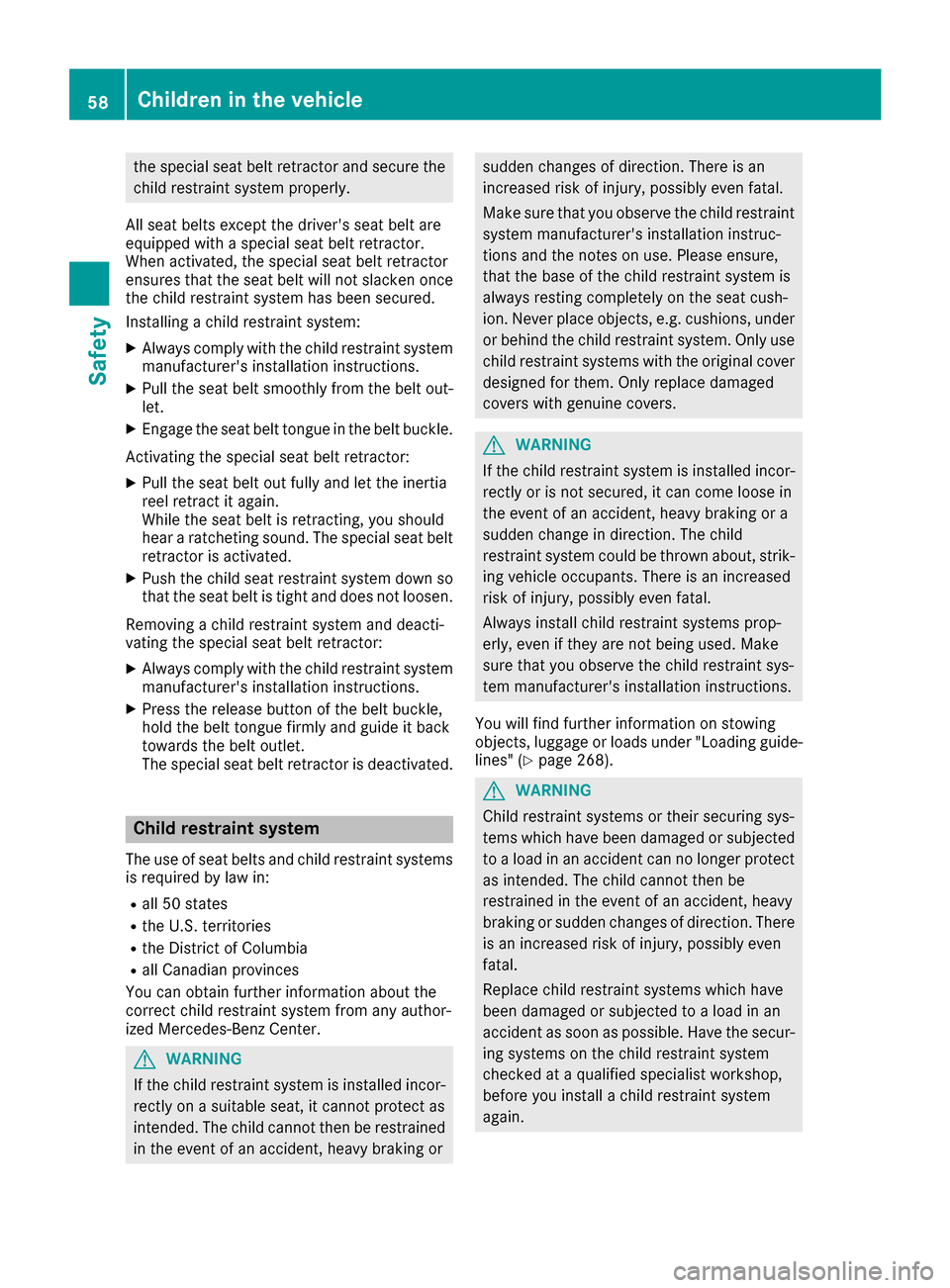
the special seat belt retractorand secur ethe
child restraint systemp roperly.
All seat belts except the driver's seat belt are
equipped with aspecial seat belt retractor.
When activated ,the special seat belt retractor
ensures thatt he seat belt will not slacke nonce
the child restraint systemh asbeen secured.
Installing achild restraint system:
XAlway scomply with the child restraint system
manufacturer's installatio ninstructions.
XPull the seat belt smoothl yfromt he belt out-
let.
XEngage the seat belt tongue in the belt buckle.
Activating the special seat belt retractor:
XPull the seat belt ou tfully and le tthe inertia
ree lretract it again.
Whil ethe seat belt is retracting, yo ushould
hear aratcheting sound. The special seat belt
retracto risactivated.
XPush the child seat restraint systemd owns o
thatt he seat belt is tight and does not loosen.
Removing achild restraint systema nd deacti-
vating the special seat belt retractor:
XAlway scomply with the child restraint system
manufacturer's installatio ninstructions.
XPress the release button of the belt buckle,
hol dthe belt tongue firmlya nd guideitback
towa
rds the belt outlet.
The special seat belt retracto risdeactivated.
Chil drestrain tsystem
The us eofseatb elts and child restraint systems
is required by la win:
Rall50s tates
Rthe U.S. territories
Rthe Distric tofColumbia
RallC anadia nprovinces
Yo uc an obtai nfurthe rinformation abou tthe
correct child restraint systemf romany author-
ize dM ercedes-Benz Center.
GWARNING
If the child restraint systemisi nstalledincor-
rectl yonas uitabl eseat, it cannot protect as
intended. The child cannot thenb erestrained
in the event of an accident, heav ybraking or
sudden change sofdirection. There is an
increasedr iskofi njury,p ossibl yevenf atal.
Make sure thaty ouobserve the child restraint
systemm anufacturer's installatio ninstruc-
tions and the note sonuse.P leas eensure,
thatt he base of the child restraint systemi s
always resting completel yonthe seat cush-
ion. Never place objects ,e.g.c ushions ,under
or behind the child restraint system. Onlyu se
child restraint systems with the original cover
designe dfor them. Onlyr eplace damaged
covers with genuine covers.
GWARNING
If the child restraint systemisi nstalledincor-
rectl yorisn ot secured ,itcan come loose in
the event of an accident, heav ybraking or a
sudden change in direction. Th echild
restraint systemc ould be thrown about, strik-
ing vehicl eoccupants. There is an increased
ris kofi njury,p ossibl yevenf atal.
Alway sinstal lchild restraint systems prop-
erly, eve niftheya renot being used .Make
sure thaty ouobserve the child restraint sys-
tem manufacturer's installatio ninstructions.
Yo uw illf indf urthe rinformation on stowing
objects ,luggage or loadsunder "Loading guide-
lines "(
Ypage 268).
GWARNING
Chil drestraint systems or their securing sys-
tems which have been damage dorsubjected
to aloa dinana ccident can no longe rprotect
as intended. Th echild cannot thenb e
restraine dinthe event of an accident, heavy
braking or sudden change sofdirection. There
is an increasedr iskofi njury,p ossibl yeven
fatal.
Replace child restraint systems which have
been damage dorsubjected to aloa dina n
accident as soo naspossible. Hav ethe secur-
ing systems on the child restraint system
checked at aquali fied specialis tworkshop,
befor eyou instal lachild restraint system
again.
58Children in the vehicle
Safety
Page 69 of 354

ESP®(Electronic Stability Program)
General notes
iObserv ethe "Important safety notes" sec-
tio n(Ypage 61).
ESP
®monitors driving stabilitya nd traction,i.e.
power transmission between th etires and the
road surface.
If ESP
®detect stha tthe vehicle is deviatin gfrom
th ed irection desired by th edriver, oneorm ore
wheels are braked to stabilizet hevehicle .The
engine output is also modified to keep th evehi-
cle on th edesired course within physical limits.
ESP
®assists th edriver when pullinga way on
wet or slippery roads. ESP®can also stabilize
th ev ehicle durin gbraking.
Important safety notes
iObserv ethe "Important safety notes" sec-
tio n(Ypage 61).
GWARNING
If ESP
®is malfunctioning, ESP®is unabl eto
stabilizet hevehicle .Additionally, further driv-
ing safety systems are deactivated. This
increases th erisk of skiddinga nd an accident.
Drive on carefully. Hav eESP
®checked at a
qualified specialist workshop.
When towing th evehicle with th erear axle
raised, observ ethe note sonE SP
®
(Ypage 311).
If the å ESP®OFFw arning lamp lightsu p
continuously, ESP®is deactivated.
If the ÷ ESP®warning lamp lightsupc ontin-
uously, ESP®is no tavailabl edue to amalfunc-
tion.
Observ ethe informatio nonwarning lamps
(
Ypage 249) and display messages whichm ay
be shown in th einstrumen tcluster
(
Ypage 220).
Only use wheels with th erecommended tire
sizes. Only then will ESP
®function properly.
Characteristics of ESP®
General information
If the ÷ ESP®warning lamp goes out before
beginnin gthe journey, ESP®is automatically
active.
If ESP
®intervenes, the ÷ESP®warning lamp
flashes in th einstrumen tcluster.
If ESP
®intervenes:
XDo no tdeactivate ESP®unde rany circum-
stances.
XOnly depress th eaccelerato rpedal as far as
necessaryw hen pullinga way.
XAdaptyour driving style to suit th eprevailing
road and weather conditions.
ECO start/stop function
The ECO start/sto pfunction switches the
engine off automaticall ywhen th evehicle stops
moving .The engine start sautomaticall ywhen
th ed river want stopull away again.E SP
®
remains in its previously selecte dstatus. Exam-
ple: if ESP®was deactivate dbefore th eengine
was switched off ,ESP®remains deactivated
when th eengine is switched on again.
Deactivating/activatin gESP®(except
Mercedes ‑AM Gvehicles)
Important safety notes
iObserv ethe "Important safety notes" sec-
tio n(Ypage 61).
You can selectb etween thefollowings tate so f
ESP
®:
RESP®is activated.
RESP®is deactivated.
GWARNING
If you deactivate ESP
®,E SP®no longer sta-
bilizes th evehicle .Thereisani ncreased risk
of skiddinga nd an accident.
Only deactivate ESP
®in th esituations descri-
bed in th efollowing.
Driving safety systems67
Safety
Z
Page 83 of 354
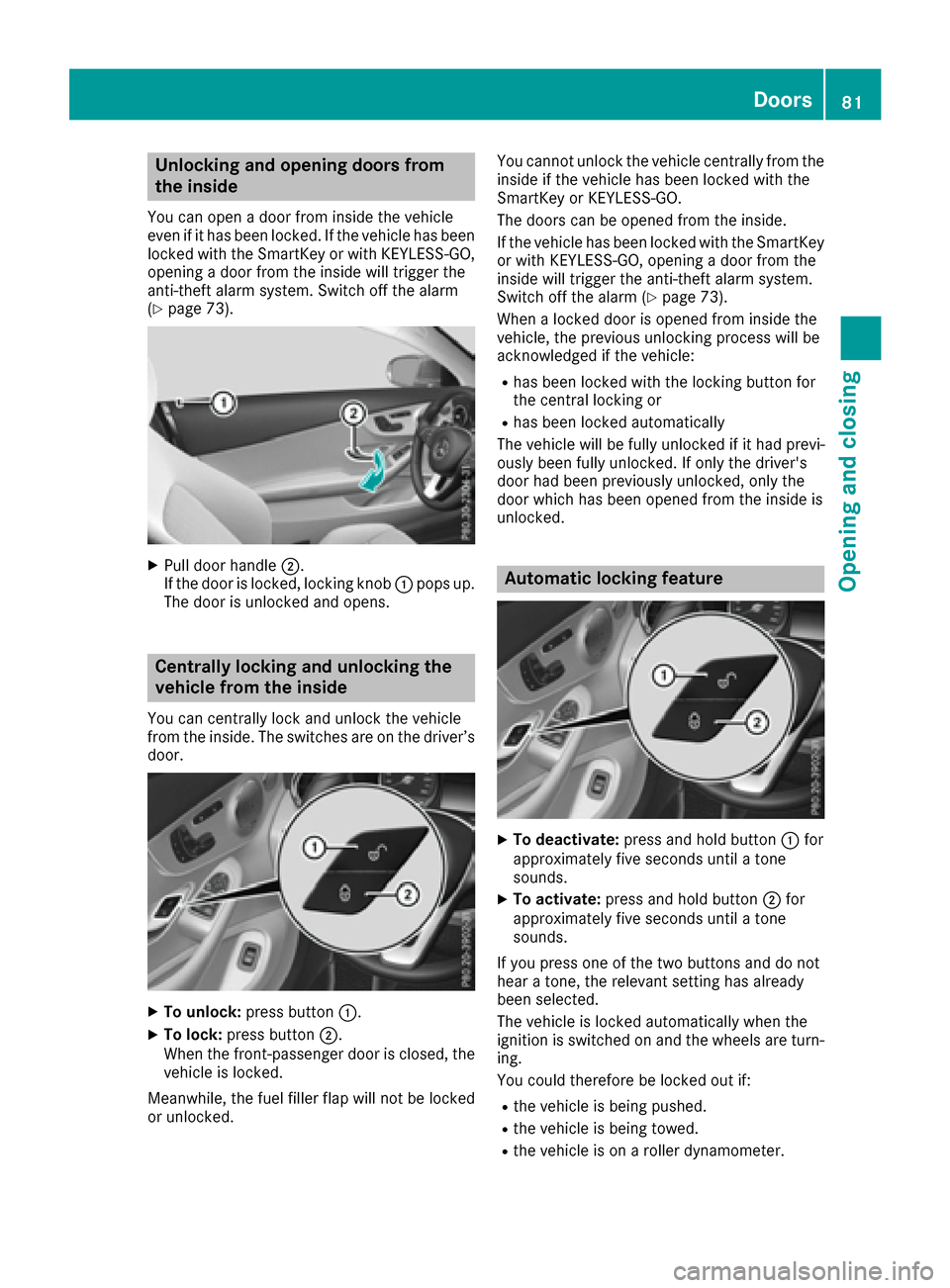
Unlocking and opening doors from
the inside
You can openadoor from inside the vehicle
even if it has been locked. If the vehicle has been
locked with the SmartKey or with KEYLESS-GO,
openin gadoor from the inside will trigger the
anti-theft alarm system .Switc hoff the alarm
(
Ypage 73).
XPull door handle ;.
If the door is locked, locking knob :pops up.
The door is unlocked and opens.
Centrally locking and unlocking the
vehicle from the inside
You can centrally lock and unlock the vehicle
from the inside. The switches are on the driver’s
door.
XTo unlock: press button :.
XTo lock:press button ;.
When the front-passenge rdoor is closed, the
vehicle is locked.
Meanwhile, the fuel filler flap will not be locked
or unlocked. You cannot unlock the vehicle centrally from the
inside if the vehicle has been locked with the
SmartKey or KEYLESS-GO.
The doors can be opened from the inside.
If the vehicle has been locked with the SmartKey
or with KEYLESS-GO, openin gadoor from the
inside will trigger the anti-theft alarm system.
Switc hoff the alarm (
Ypage 73).
When alocked door is opened from inside the
vehicle, the previous unlocking process will be
acknowledged if the vehicle:
Rhas been locked with the locking button for
the central locking or
Rhas been locked automatically
The vehicle will be fully unlocked if it had previ-
ously been fully unlocked. If only the driver's
door had been previously unlocked, only the
door which has been opened from the inside is
unlocked.
Automatic locking feature
XTo deactivate: press and hold button :for
approximately five seconds until atone
sounds.
XTo activate: press and hold button ;for
approximately five seconds until atone
sounds.
If you press one of the two buttons and do not
hear atone, the relevants etting has already
been selected.
The vehicle is locked automatically when the
ignition is switched on and the wheels are turn-
ing.
You could therefore be locked out if:
Rthe vehicle is being pushed.
Rthe vehicle is being towed.
Rthe vehicle is on aroller dynamometer.
Doors81
Opening and closing
Z
Page 132 of 354

Notesonb reaking-in anew vehicle
Important safety notes
Thes ensors ystemofs omedriving and driving
safety systems adjusts automaticall ywhile a
certai ndistance is being driven after the vehicle
ha sb eend elivere dorafter repairs. Full system
effectiveness is not reache duntilthe end of this
teach-i nprocedure.
New and replaced brake pads and discs only
reach their optimum braking effect after several hundred kilometers of driving. Compensate for
thi sb yapplyin ggreate rforce to the brake pedal.
The first 1000 miles (150 0km)
Them orey ou look after the engine when it is
new ,the mor esatisfied yo uwillbew ithi ts per-
formance in the future.
RYo us houl dtherefore drive at varying vehicle
and engine speeds for the first 1000 miles
(1500 km).
RAvoi dheavy loads, e.g .driving at full throttle,
during thi speriod.
RWhen changing gear smanually, change up in
good time, befor ethe tachomete rneedl erea-
ches Ôof the wa ytothe red area of the tach-
ometer.
RDo not manuall yshift to alower gear to brake
the vehicle.
RTry to avoi ddepressing the accelerator pedal
beyond the point of resistanc e(kickdown).
RAllv eh icle s(exce pt Mercedes-AMG vehi-
cles): ideally, for the first 1,000 miles
(1,500 km), drive in drive program E.
Additiona lbreaking-i nnote sfor Mercedes-AMG
vehicles:
RDo not drive fastert han8 5m ph (14 0km/h)
for the first 1,000 mile s(1,500 km).
ROnl yallow the engine to reach amaximum
engine spee dof4,500 rpm briefly.
RChang egearing oodt ime.
RIdeally ,for the first 1,000 mile s(1,500 km),
drive in program C.
After 1000 mile s(1500 km), you can increase
th ee ngi
n espeed gradually and accelerate th e
vehicl etofull speed.
You should also observ ethese note sonbreak-
in ginift heengin eorp artsoft hedrive train on
your vehicl ehaveb een replaced. Always observ
ethe maximum permissibl e
speed.
Self-lockin greara xled ifferential
(Mercedes-AMG vehicles)
Your vehicl eisequipped wit haself-locking dif -
ferential on th erear axle.
Change th eoil to improv eprotection of th erear
axl ed ifferential:
Rafter abreaking-i nperiod of 1,850 mile s
(3,00 0km)
Revery 31,00 0miles( 50,00 0km) or 3years
These oil changes prolon gthe servic elife of th e
differential. Hav ethe oil chang ecarrie dout at a
qualified specialist workshop .
Driving
Important safety notes
GWARNIN G
Objects in th edriver's footwell can restrict th e
pedal travel or obstruct adepressed pedal .
The operating and roa dsafet yoft hevehicl eis
jeopardized. There is ariskofana ccident.
Mak esuret hata ll objects in th evehicl eare
stowed correctly, and that they canno tenter
th ed river's footwell. Install th efloormats
securel yand as specified in order to ensur e
sufficien tclearance for th epedals. Do no tuse
loos efloormats and do no tplac efloormats on
to pofo neanother.
GWARNIN G
Unsuitable footwear can hinder correc tusage
of th epedals, e.g. :
Rshoes withthick sole s
Rshoes wit hhigh heels
Rslipper s
There is ariskofana ccident.
Wear suitable footwear to ensur ecorrect
usage of th epedals.
130Driving
Driving and parking
Page 144 of 354
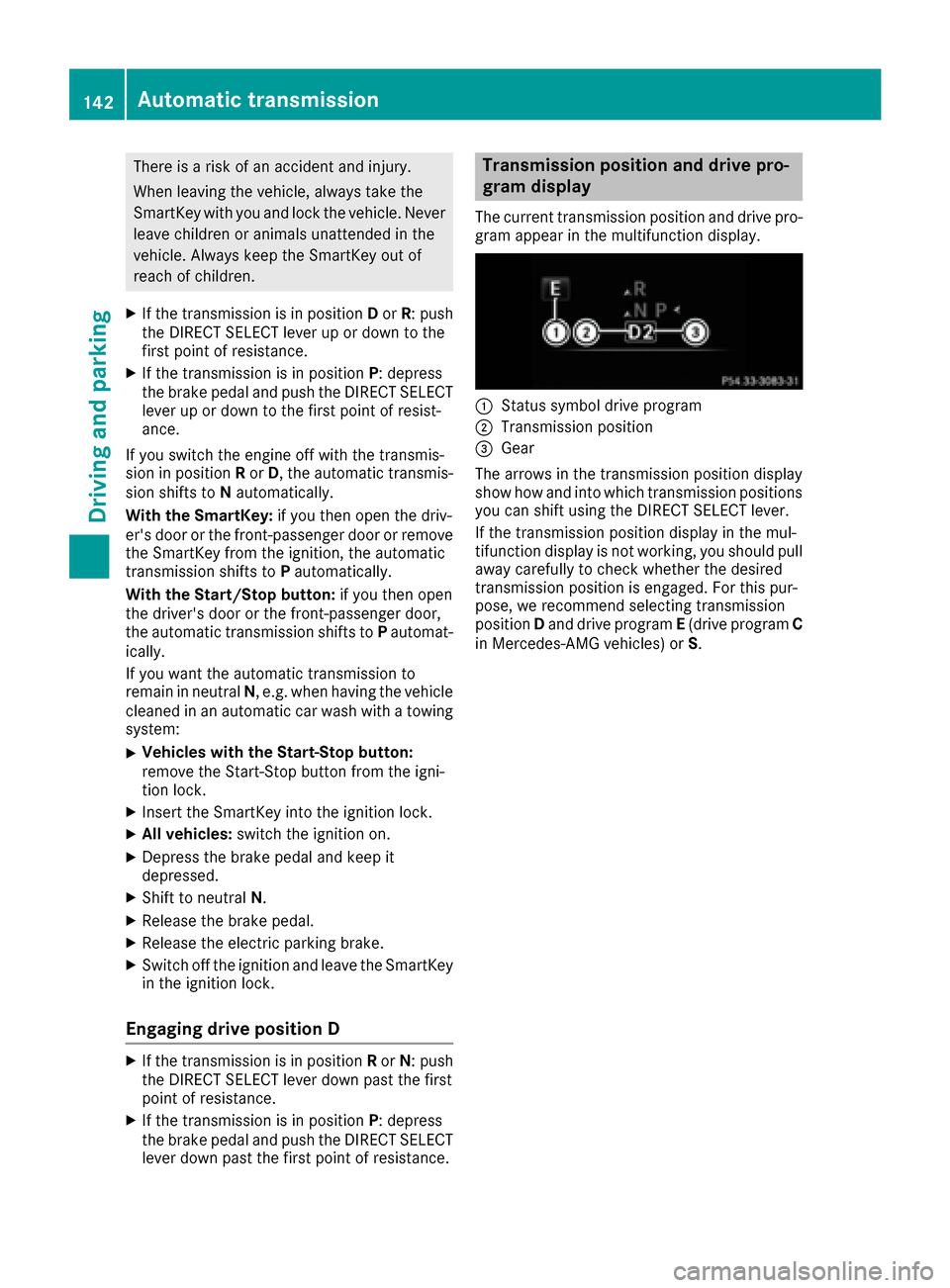
There isarisk of an accident and injury.
When leaving the vehicle, alwayst ake the
SmartKey with you and lock the vehicle. Never
leave children or animals unattended in the
vehicle. Always keep the SmartKey out of
reach of children.
XIf the transmission is in position Dor R:p ush
the DIRECT SELECT lever up or down to the
first point of resistance.
XIf the transmission is in position P:depress
the brake pedal and push the DIRECT SELECT
lever up or down to the first point of resist-
ance.
If you switch the engine off with the transmis-
sion in position Ror D,t he automatic transmis-
sion shifts to Nautomatically.
With the SmartKey: if you then open the driv-
er's door or the front-passenger door or remove
the SmartKey from the ignition, the automatic
transmission shifts to Pautomatically.
With the Start/Stop button: if you then open
the driver's door or the front-passenger door,
the automatic transmission shifts to Pautomat-
ically.
If you want the automatic transmission to
remain in neutral N,e .g. when having the vehicle
cleaned in an automatic car wash with atowing
system:
XVehicles with the Start-Stop button:
remove the Start-Stop button from the igni-
tion lock.
XInsert the SmartKey into the ignition lock.
XAll vehicles: switch the ignition on.
XDepress the brake pedal and keep it
depressed.
XShift to neutral N.
XRelease the brake pedal.
XRelease the electric parking brake.
XSwitch off the ignition and leave the SmartKey
in the ignition lock.
Engaging drive position D
XIf the transmission is in position Ror N:p ush
the DIRECT SELECT lever down past the first
point of resistance.
XIf the transmission is in position P:depress
the brake pedal and push the DIRECT SELECT lever down past the first point of resistance.
Transmission position and drive pro-
gram display
The current transmission position and drive pro-
gram appear in the multifunction display.
:Status symbol drive program
;Transmission position
=Gear
The arrows in the transmission position display
show how and into which transmission positions
you can shift using the DIRECT SELECT lever.
If the transmission position display in the mul-
tifunction display is not working, you should pull
away carefully to check whether the desired
transmission position is engaged. For this pur-
pose, we recommend selectin gtransmission
position Dand drive program E(drive program C
in Mercedes-AMG vehicles) or S.
142Automatic transmission
Driving and parking
Page 145 of 354

Transmission positions
BPark position
Thisprevents the vehicl efromr olling
away when stopped.
Onlys hift the transmission into posi-
tion Pwhen the vehicl eisstationary
(
Ypage 141). The parkin gloc k
shoul dnot be used as abrake when
parking. Alway sapply the electronic
parkin gbrake in additio ntothe park-
ing lock in order to secur ethe vehi-
cle.
Park position Pis automatically
engaged if:
Ryo us witch off the engine using the
SmartKeya nd remove the Smart-
Key
Ryo us witch off the engine using the
key or using the Start/Stop button
and open the driver's door or front-
passenge rdoor
Rthe driver's door is opene dwhen
the vehicl eisstationar yordriving
at ver ylow spee dand the trans-
mission is in position Dor R
If the vehicl eelectronics ar emalfunc-
tioning ,the transmission mayb e
locked in position P.H avet he vehicle
electronics checked immediatel yata
qualified specialis tworkshop.
CRevers egear
Onlys hift the transmission into posi-
tion Rwhen the vehicl eisstationary.
ANeutral
Do not shift the transmission to N
whil edriving. Otherwise, the auto-
matic transmission could be dam-
aged.
No powe ristransmitted fromt he
engine to the drive wheels.
Releasing the brake peda lwilla llow
yo utom ovet he vehicl efreely, e.g .to
push it or tow it.
If ESP
®is deactivated or faulty: shift
the transmission to position Nif the
vehicl eisind angerofs kidding,e.g.
on icy roads.
If yo uswitch the engine off with the
transmission in position Ror D,t he
automatic transmission shifts to N
automatically.
!Rolling in neutral Ncan damage
the drive train.
7Drive
The automatic transmission changes
gear automatically. All forward gears
ar ea vailable.
Driving tips
Changin ggear
The automatic transmission shifts to the indi-
vidua lgears automaticall ywhenitisint rans-
mission position D.T hisa utomatic gear shifting
behavio risdetermine dby:
Rthe selecte ddrive program
Rthe positio nofthe accelerator pedal
Rthe roa dspeed
Accelerator peda lposition
Your style of drivin ginfluences how the auto-
matic transmission shifts gear:
Rlittle throttle :early upshifts
Rmor ethrottle :lat eu pshifts
Double-clutc hfunction
When shifting down, the double-clutch function
is active regardless of the currentl yselected
drive program. The double-clutch function
Automati ctransmission143
Driving an dparking
Z
Page 151 of 354

Problems with the transmission
ProblemPossible causes/consequences andMSolutions
The transmission has
problems shifting gear.The transmission is losing oil.
XHave the transmission checked ataqualified specialist workshop
immediately.
The acceleration ability
is deteriorating.
The transmission no lon-
ger changes gear.The transmission is in emergency mode.
It is only possible to shift into secondgear and reverse gear.
XStop the vehicle.
XShift the transmission to position P.
XSwitch off the engine.
XWait at least ten seconds before restarting the engine.
XShift the transmission to positionDor R.
If D is selected, the transmission shifts into secondgear; ifRis
selected, the transmission shifts into reverse gear.
XHave the transmission checked at aqualified specialist workshop
immediately.
Transfer case
This section is only valid for vehicles with 4-
wheel drive (4MATIC). Power is always trans-
mitted to both axles.
!Performancet ests may only be carried out
on a2 -axle dynamometer. The brake system
or transfer case could otherwise be damaged. Contact aqualified specialist workshop for a
performancet est.
!Since ESP®engages automatically, the igni-
tion must be switched off (the SmartKey or
Start/Stop button must be in position 0or 1)
if:
Rthe electric parking brake is being tested
on abrake dynamometer
Rthe vehicle is being towed with only one
axle raised (not permitted for vehicles with
4MATIC).
The brake system could otherwise be dam-
aged.
!Vehicles with 4MATIC must not be towed
with either the front or the rear axle raised, as doing so will damage the transmission.
Refueling
Important safety notes
GWARNING
Fuel is highly flammable. If you handle fuel
incorrectly, there is arisk of fire and explo-
sion.
You must avoid fire, open flames, creating
sparks and smoking. Switch off the engine
and, if applicable, the auxiliary heating before refueling.
GWARNING
Fuel is poisonous and hazardous to health.
There is arisk of injury.
You must make sure that fuel does not come into contact with your skin, eyes or clothing
and that it is not swallowed. Do not inhale fuel
vapors. Keep fuel away from children.
If you or others come into contact with fuel,
observe the following:
RWash away fuel from skin immediately
using soap and water.
RIf fuel comes into contact with your eyes,
immediately rinse them thoroughly with
Refueling149
Driving and parking
Z
Page 155 of 354
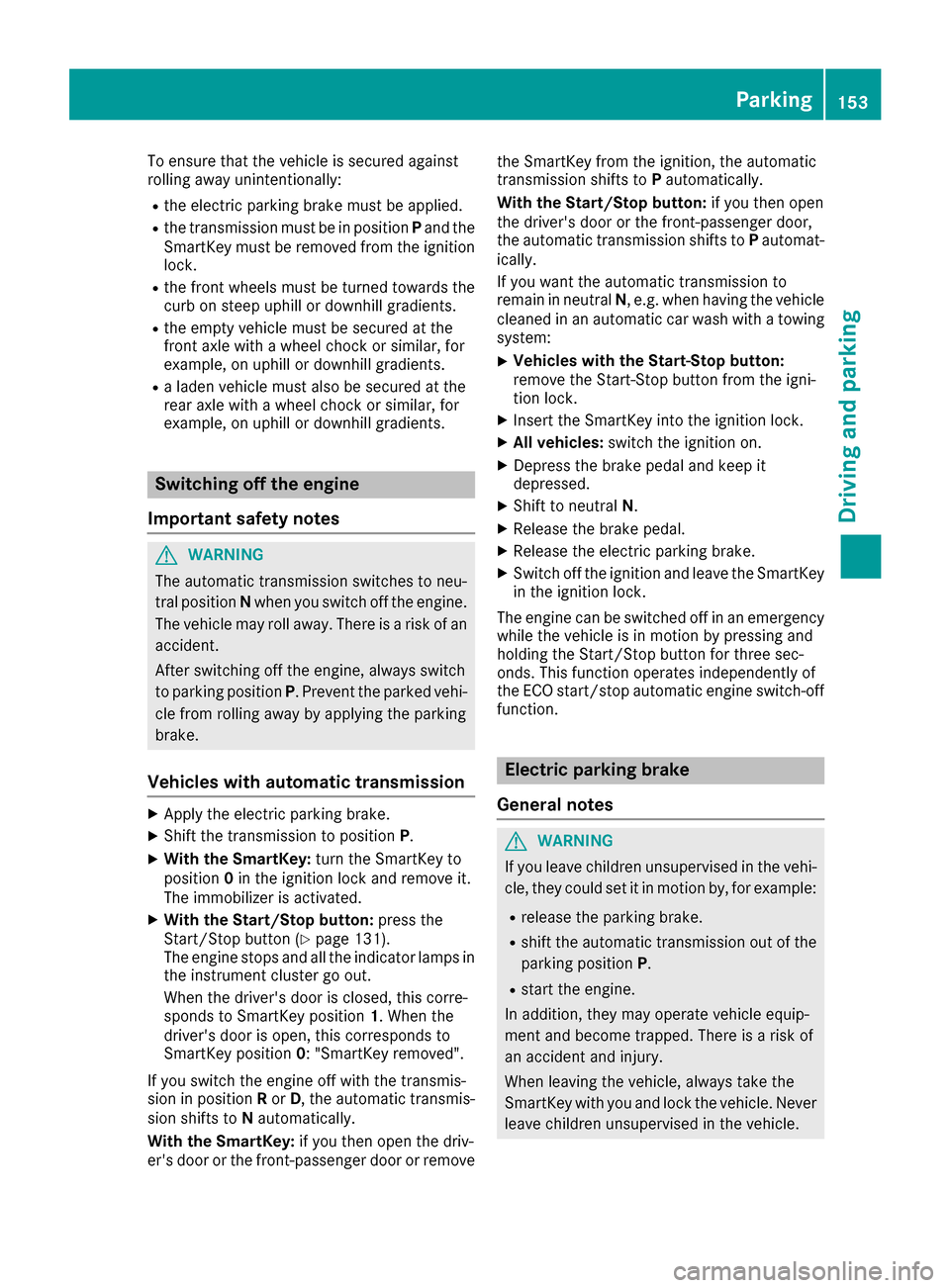
To ensure that the vehicle is secured against
rolling away unintentionally:
Rthe electric parking brake must be applied.
Rthe transmission must be in positionPand the
SmartKey must be removed from the ignition
lock.
Rthe front wheels must be turned towards the
curb on steep uphill or downhill gradients.
Rthe empty vehicle must be secured at the
front axle with awheel chock or similar, for
example, on uphill or downhill gradients.
Ral aden vehicle must also be secured at the
rear axle with awheel chock or similar, for
example, on uphill or downhill gradients.
Switching off the engine
Important safety notes
GWARNING
The automatic transmission switches to neu-
tral position Nwhen you switch off the engine.
The vehicle may roll away.T here isarisk of an
accident.
After switching off the engine, alwayss witch
to parking position P.Prevent the parked vehi-
cle from rolling away by applying the parking
brake.
Vehicles with automatic transmission
XApply the electric parking brake.
XShift the transmission to position P.
XWith the SmartKey:turn the SmartKey to
position 0in the ignition lock and remove it.
The immobilizer is activated.
XWith the Start/Stop button: press the
Start/Stop button (Ypage 131).
The engine stops and all the indicator lamps in
the instrument cluster go out.
When the driver's door is closed, this corre-
sponds to SmartKey position 1.When the
driver's door is open, this corresponds to
SmartKey position 0:"SmartKey removed".
If you switch the engine off with the transmis-
sion in position Ror D,t he automatic transmis-
sion shifts to Nautomatically.
With the SmartKey: if you then open the driv-
er's door or the front-passenger door or remove the SmartKey from the ignition, the automatic
transmission shifts to
Pautomatically.
With the Start/Stop button: if you then open
the driver's door or the front-passenger door,
the automatic transmission shifts to Pautomat-
ically.
If you want the automatic transmission to
remain in neutral N,e .g. when having the vehicle
cleaned in an automatic car wash with atowing
system:
XVehicles with the Start-Stop button:
remove the Start-Stop button from the igni-
tion lock.
XInsert the SmartKey into the ignition lock.
XAll vehicles: switch the ignition on.
XDepress the brake pedal and keep it
depressed.
XShift to neutral N.
XRelease the brake pedal.
XRelease the electric parking brake.
XSwitch off the ignition and leave the SmartKey
in the ignition lock.
The engine can be switched off in an emergency
while the vehicle is in motion by pressing and
holding the Start/Stop button for three sec-
onds. This function operates independently of
the ECO start/sto pautomatic engine switch-off
function.
Electric parking brake
General notes
GWARNING
If you leave children unsupervised in the vehi-
cle, they could set it in motion by, for example:
Rrelease the parking brake.
Rshift the automatic transmission out of the
parking position P.
Rstart the engine.
In addition, they may operate vehicle equip-
ment and become trapped. There is arisk of
an accident and injury.
When leaving the vehicle, alwayst ake the
SmartKey with you and lock the vehicle. Never
leave children unsupervised in the vehicle.
Parking153
Driving and parking
Z
Page 162 of 354
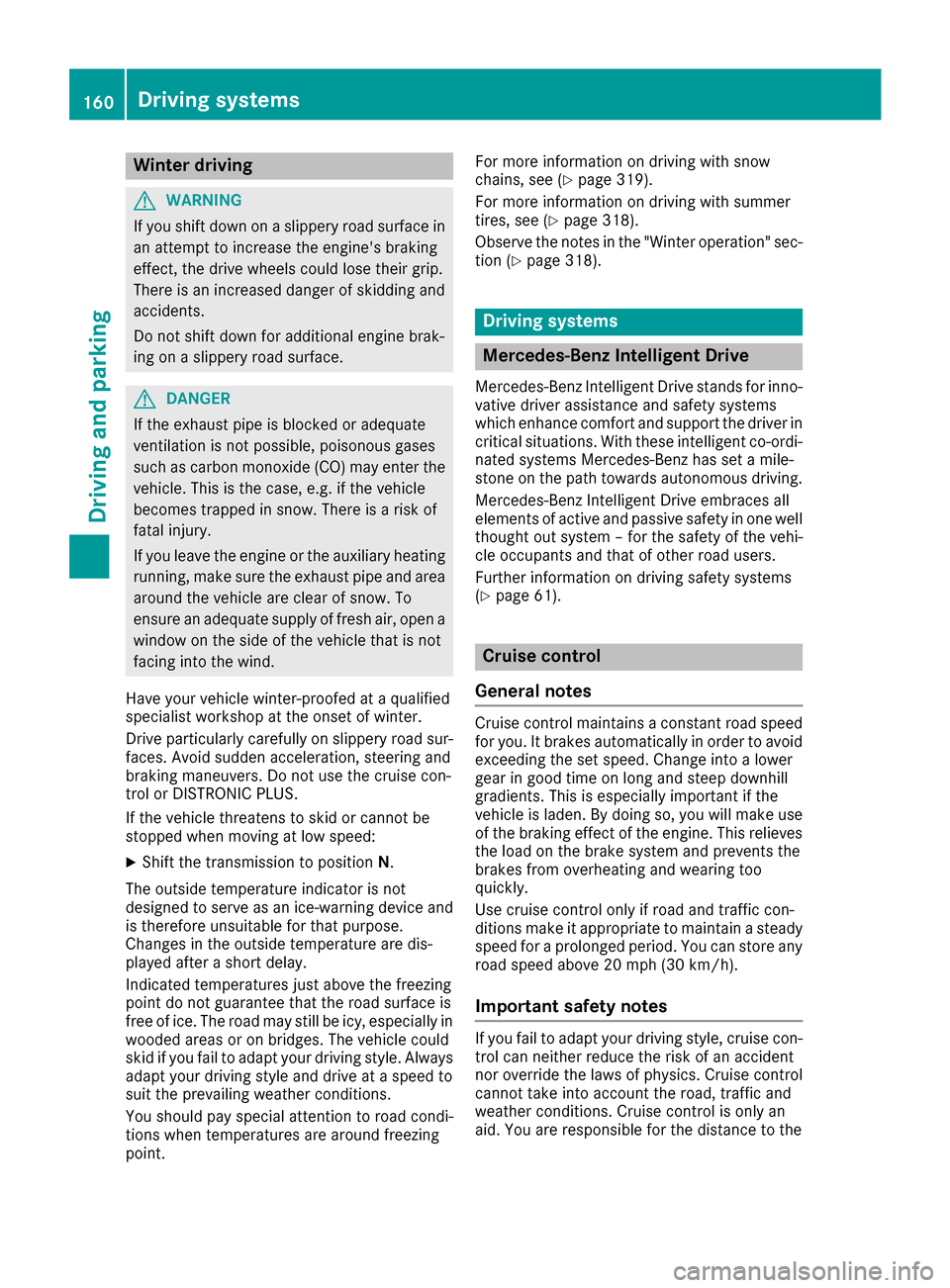
Winter driving
GWARNING
If you shift downonaslipperyr oad surface in
an attempt to increas ethe engine' sbraking
effect, the drive wheels coul dlose their grip.
There is an increased dange rofskidding and
accidents.
Do not shift downf or additionalengine brak-
ing on aslipperyr oad surface.
GDANGER
If the exhaust pip eisblocked or adequate
ventilation is not possible ,poisonousg ases
such as carbo nmonoxide (CO )may enter the
vehicle. This is the case, e.g. if the vehicle
becomest rappedinsnow. There is arisk of
fatal injury.
If you leave the engine or the auxiliary heating
running, make sure the exhaust pip eand area
around the vehicl eare clearofs now. To
ensure an adequate supply of fresh air, open a
window on the side of the vehicl ethat is not
facing into the wind.
Have you rvehicl ewinter-proofed at aqualified
specialist worksho patthe onset of winter.
Drive particularly carefully on slipperyr oad sur-
faces. Avoid sudden acceleration, steering and
braking maneuvers. Do not use the cruis econ-
trol or DISTRONIC PLUS.
If the vehicl ethreatens to skid or cannot be
stoppedw hen moving at low speed:
XShift the transmission to position N.
The outside temperature indicator is not
designed to serve as an ice-warning device and
is therefore unsuitable for that purpose.
Changes in the outside temperature are dis-
played after ashort delay.
Indicated temperatures just above the freezing
point do not guarantee that the road surface is
free of ice. The road may still be icy, especially in
wooded area soronbridges. The vehicl ecould
skid if you fail to adapt you rdriving style .Always
adapt you rdriving style and drive at aspeedt o
sui tthe prevailing weather conditions.
You should pay special attention to road condi-
tions when temperatures are around freezing
point. For more information on driving with snow
chains, see (
Ypag
e319).
For more information on driving with summer
tires, see (
Ypag e318).
Observe the notes i
n the "Winter operation" sec-
tion (Ypag e318).
Driving systems
Mercedes-Ben zIntelligen tDrive
Mercedes-Benz Intelligent Drive stands for inno-
vative drive rassistance and safety systems
which enhance comfort and support the drive rin
critical situations. With these intelligent co-ordi-
nated systems Mercedes-Benz has set amile-
stone on the path towards autonomous driving.
Mercedes-Benz Intelligent Drive embraces all
elements of active and passive safety in one well
though tout syste m–for the safety of the vehi-
cle occupants and that of other road users.
Further information on driving safety systems
(
Ypag e61).
Cruise control
General notes
Cruise control maintains aconstant road speed
for you .Itbrakes automatically in order to avoid
exceeding the set speed. Change into alower
gearing ood time on long and steep downhill
gradients. This is especially important if the
vehicl eisladen. By doing so, you wil lmake use
of the braking effect of the engine. This relieves
the loa donthe brake syste mand prevents the
brakes from overheating and wearing too
quickly.
Use cruis econtrol only if road and traffic con-
ditions make it appropriate to maintain asteady
speedf orap rolonged period. You can store any
road speeda bove 20 mph (30 km/h).
Important safety notes
If you fail to adapt you rdriving style ,cruis econ-
trol can neither reduce the risk of an accident
nor override the law sofphysics. Cruise control
cannot take into account the road ,traffic and
weather conditions. Cruise control is only an
aid .You are responsiblef or the distance to the
160Driving systems
Driving and parking
Page 163 of 354

vehicleinfront, for vehicl espeed, for braking in
good time and for staying in you rlane.
Do not use cruise control:
Rin road and traffic conditions which do not
allow you to maintai naconstant speed, e.g. in
heavy traffic or on winding roads
Ron slippery road surfaces. Braking or accel-
erating could caus ethe drive wheels to lose
traction and the vehicl ecould then skid
Rwhen there is poor visibility, e.g. due to fog,
heavy rain or snow
If there is achange of drivers ,advise the new
driver of the speeds tored.
iThe speedindicated in the speedometer
may differ slightly from the speeds tored.
Cruise control lever
:Activates or increasesspeed
;Activates or reduces speed
=Deactivates cruise control
?Activates at the current speed/last stored
speed
When you activate cruise control, the stored
speediss howninthe multifunction display for
five seconds. In addition, the ésymbol
appears in the multifunction display.
Speedometer with segments: when cruise
control is activated ,the segments from the
stored speedtot he maximumpermitted speed
light up.
Storing and maintainingt he current
speed
You can store the current speedify ou are driv-
ing faster than 20 mph (30 km/h).
XAccelerate the vehicl etothe desired speed.
XBriefly press the cruise control lever up :or
down ;.
XRemove you rfoot from the accelerator pedal.
Cruise control is activated .The vehicl eauto-
matically maintains the stored speed.
iCruise control may be unable to maintain
the stored speedonu phill gradients. The
stored speedisr esumedwhen the gradient
evens out. Cruise control maintains the
stored speedond ownhill gradients by auto-
matically applying the brakes.
Storing the current spee dorcalling up
the last stored speed
GWARNING
If you call up the stored speeda nd it is lower
than the current speed, the vehicl edeceler-
ates. If you do not know the stored speed, the vehicl ecould decelerate unexpectedly. There
is ar isk of an accident.
Pay attention to the road and traffic condi-
tions before calling up the stored speed. If you
do not know the stored speed, store the
desired speeda gain.
XBriefly pullthe cruise control lever towards
you ?.
XRemove you rfoot from the accelerator pedal.
The first time cruise control is activated ,it
stores the current speedorr egulates the
speedoft he vehicletothe previousl ystored
speed.
Setting aspeed
Keep in mind that it may take abrief moment
until the vehicl ehas accelerated or braked to
the speeds et.
XPress the cruise control lever up :for a
highers peedord own;for alower speed.
XTo adjust the set spee din1 mph incre-
ments (1 km/h increments): brieflypress
Driving systems161
Driving and parking
Z